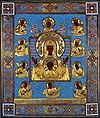- Our Lady of Kursk
-
Our Lady of Kursk (Russian: Богоматерь Курская Коренная, Bogomater Kurskaya Korennaya, literally Theotokos of Kursk, Found Among the Roots) is an icon of Theotokos of the Sign, apparently painted in the thirteenth century and discovered in a forest near Kursk ca. 1300. It was preserved in the Black Hermitage of the Roots (Chornaya Korennaya Pustyn), an abbey founded on the spot of its discovery. It was regularly brought from the abbey to Kursk in a great procession involving thousands of peasants and pilgrims. This ceremony is depicted in the famous painting by Ilya Repin; see Religious Procession in Kursk Province.
The icon actually incorporates as many as twelve figures on it: Theotokos, Infant Christ, God the Father above them (with the Holy Spirit as a dove) and nine Old Testament prophets. The image of Theotokos belongs to the Panagia type. It was regarded as a palladion of the Russian Imperial Army. After the Russian Revolution, the icon was brought by the White Army outside of Russia, where it is now held in New-York by the Russian Orthodox Church Outside Russia.
The monastery near Kursk where the icon was held was formerly very rich and hosted one of the largest fairs in Imperial Russia. During the Soviet period the monastery cathedral (designed by Konstantin Thon) was demolished; restoration works are planned.
External links
- (Russian) Online shrine
- (English) History with photo of Icon in its riza (metal cover)
- (English) The Kursk-Root Icon of the Mother of God Will Visit Kiev
- (Russian) О Коренно-Курской иконе Божией Матери
Town-protecting Marian icons of Russia and Ukraine 
National
venerationVladimirskaya (Vladimir and Moscow) · Znamenie (Novgorod) · Smolenskaya (Smolensk) · Feodorovskaya (Kostroma) · Kurskaya (Kursk) · Tolgskaya (Yaroslavl) · Tikhvinskaya (Tikhvin and Northwest Russia) · Kazanskaya (Kazan and all of Russia) 
Regional
venerationList of oldest Russian icons · Iverskaya · Vlakhernskaya · Donskaya · Pochayivska · Kholmska · Derzhavnaya Categories:- Eastern Orthodox icons of the Virgin Mary
- Marian shrines
- Kursk
Wikimedia Foundation. 2010.

